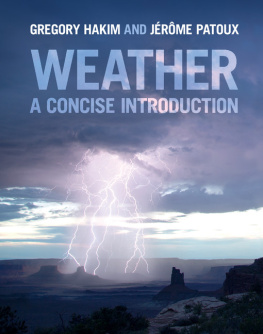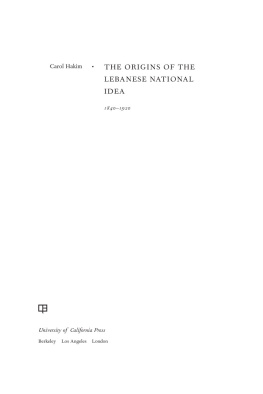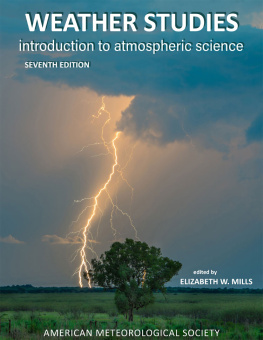Gregory J. Hakim - Weather: A Concise Introduction
Here you can read online Gregory J. Hakim - Weather: A Concise Introduction full text of the book (entire story) in english for free. Download pdf and epub, get meaning, cover and reviews about this ebook. year: 2017, publisher: Cambridge University Press, genre: Children. Description of the work, (preface) as well as reviews are available. Best literature library LitArk.com created for fans of good reading and offers a wide selection of genres:
Romance novel
Science fiction
Adventure
Detective
Science
History
Home and family
Prose
Art
Politics
Computer
Non-fiction
Religion
Business
Children
Humor
Choose a favorite category and find really read worthwhile books. Enjoy immersion in the world of imagination, feel the emotions of the characters or learn something new for yourself, make an fascinating discovery.
- Book:Weather: A Concise Introduction
- Author:
- Publisher:Cambridge University Press
- Genre:
- Year:2017
- Rating:4 / 5
- Favourites:Add to favourites
- Your mark:
- 80
- 1
- 2
- 3
- 4
- 5
Weather: A Concise Introduction: summary, description and annotation
We offer to read an annotation, description, summary or preface (depends on what the author of the book "Weather: A Concise Introduction" wrote himself). If you haven't found the necessary information about the book — write in the comments, we will try to find it.
Weather: A Concise Introduction — read online for free the complete book (whole text) full work
Below is the text of the book, divided by pages. System saving the place of the last page read, allows you to conveniently read the book "Weather: A Concise Introduction" online for free, without having to search again every time where you left off. Put a bookmark, and you can go to the page where you finished reading at any time.
Font size:
Interval:
Bookmark:
Weather: A Concise Introduction
From a world-renowned team at the Department of Atmospheric Sciences at the University of Washington, Seattle, Weather: A Concise Introduction is an accessible and beautifully illustrated text covering the foundations of meteorology in a concise, clear, and engaging manner. Designed to provide students with a strong foundation in the physical, dynamical, and chemical processes taking place in the atmosphere, this introductory textbook will appeal to students with a wide range of mathematical and scientific backgrounds.
This textbook provides a practical approach to the study of meteorology. It features: a single case study of a midlatitude cyclone which is referred to throughout the whole book to illustrate the basic principles driving atmospheric dynamics and phenomena; boxes on more advanced topics; appendices for additional coverage; chapter summaries listing the take-home points discussed; and color figures and charts clearly illustrating the fundamental concepts. Key terms are evident throughout, and a glossary explains the terms that students will need to understand and become familiar with.
Gregory J. Hakim has undergraduate degrees in Mathematics and Atmospheric Science and a PhD in Atmospheric Science from the University at Albany, State University of New York. He joined the Department of Atmospheric Sciences at the University of Washington in 1999, where he served as Department Chair from 2012 to 2017 and is currently a Professor. He is also a leading scientist in the areas of weather analysis, predictability, and dynamics, and his research interests include weather and climate prediction, hurricanes, past climates, and polar circulation patterns.
He has served on the advisory panel for the Directorate of Geosciences at the National Science Foundation, as Chair of the advisory panel for the Mesoscale and Microscale Meteorology Laboratory at the National Center for Atmospheric Research (NCAR), as a member of the NCAR Advisory Panel, as a member of the NCAR Strategic Planning Council, and as Chair of the University Corporation for Atmospheric Researchs Presidents Advisory Committee on University Relations.
Jrme Patoux earned a Master in Environmental Engineering from the University of Texas at Austin and a PhD in Atmospheric Science from the University of Washington. He has been funded by the National Science Foundation (NSF), the National Aeronautics and Space Administration (NASA), the Office of Naval Research (ONR), and the National Oceanic and Atmospheric Administration (NOAA). He has taught undergraduate introductory meteorology for many years, and has been funded by the NSF to develop weather and climate curriculum. He is a former faculty member from the Department of Atmospheric Sciences at the University of Washington, and currently teaches meteorology at the University of Nantes in France.
Weather
A Concise Introduction
GREGORY HAKIM
University of Washington
JRME PATOUX
University of Washington


University Printing House, Cambridge CB2 8BS, United Kingdom
One Liberty Plaza, 20th Floor, New York, NY 10006, USA
477 Williamstown Road, Port Melbourne, VIC 3207, Australia
314321, 3rd Floor, Plot 3, Splendor Forum, Jasola District Centre, New Delhi 110025, India
79 Anson Road, #0604/06, Singapore 079906
Cambridge University Press is part of the University of Cambridge.
It furthers the Universitys mission by disseminating knowledge in the pursuit of education, learning, and research at the highest international levels of excellence.
www.cambridge.org
Information on this title: www.cambridge.org/9781108417167
DOI: 10.1017/9781108264983
Gregory Hakim and Jrme Patoux 2018
This publication is in copyright. Subject to statutory exception and to the provisions of relevant collective licensing agreements, no reproduction of any part may take place without the written permission of Cambridge University Press.
First published 2018
Printed in the United States of America by Sheridan Books, Inc.
A catalogue record for this publication is available from the British Library.
ISBN 978-1-108-41716-7 Hardback
ISBN 978-1-108-40465-5 Paperback
Cambridge University Press has no responsibility for the persistence or accuracy of URLs for external or third-party internet websites referred to in this publication and does not guarantee that any content on such websites is, or will remain, accurate or appropriate.
Having taught introductory classes on weather many times, we came to see the need for a textbook on the subject that covers the foundations of meteorology in a concise, clear, and engaging manner. We set out to create an informative, cost-effective text that meets the needs of students who may not have any background in mathematics and science. The result Weather: A Concise Introduction is an introductory meteorology textbook designed from scratch to provide students with a strong foundation in the physical, dynamical, and chemical processes taking place in the atmosphere.
This textbook is unique in that it:
provides a concise and practical approach to understanding the atmosphere;
introduces the basic physical laws early on and then ties them together with a single case study spanning the book;
presents weather analysis tools early in the book to allow instructors to engage in discussions of current weather in tandem with the basic concepts, thus attracting and retaining student interest; and
facilitates students learning and understanding of the fundamental aspects of weather analysis and forecasting, as well as practical skills, through a careful description of the forecasting process. Modern methods, such as ensemble forecasting, are central to the approach.
The main concepts of the book are illustrated in by a single case study: a midlatitude cyclone that swept through the eastern half of the USA between February 19 and 22, 2014. This rich case study serves as a common thread throughout the book, allowing students to study it from multiple perspectives. Viewing the storm in the context of different topics provides a familiar setting for mastering new subjects and for developing an holistic understanding of midlatitude cyclones.
Instructors have the option of including more advanced coverage through use of boxes that provide insights on various topics. For example, in , Weather Variables, boxes include an in-depth description of the four laws of physics that are central to the study of the atmosphere. The book contains 25 boxes, affording instructors the opportunity to tailor the level of the material that they present to students in their course.
Appendixes at the ends of include additional material on important cloud signatures found in satellite imagery, the concept of dynamic equilibrium, the cloud classification, some optical phenomena, southern hemisphere midlatitude cyclones, and the Bergen School of meteorology.
A summary of key points has been included at the end of each chapter so that students can, at a glance, confirm that they have understood the significant take-away facts and ideas.
Font size:
Interval:
Bookmark:
Similar books «Weather: A Concise Introduction»
Look at similar books to Weather: A Concise Introduction. We have selected literature similar in name and meaning in the hope of providing readers with more options to find new, interesting, not yet read works.
Discussion, reviews of the book Weather: A Concise Introduction and just readers' own opinions. Leave your comments, write what you think about the work, its meaning or the main characters. Specify what exactly you liked and what you didn't like, and why you think so.










